Abdelaziz Bouras
DISP
Chatbot Application to Support Smart Agriculture in Thailand
Jul 31, 2023Abstract:A chatbot is a software developed to help reply to text or voice conversations automatically and quickly in real time. In the agriculture sector, the existing smart agriculture systems just use data from sensing and internet of things (IoT) technologies that exclude crop cultivation knowledge to support decision-making by farmers. To enhance this, the chatbot application can be an assistant to farmers to provide crop cultivation knowledge. Consequently, we propose the LINE chatbot application as an information and knowledge representation providing crop cultivation recommendations to farmers. It works with smart agriculture and recommendation systems. Our proposed LINE chatbot application consists of five main functions (start/stop menu, main page, drip irri gation page, mist irrigation page, and monitor page). Farmers will receive information for data monitoring to support their decision-making. Moreover, they can control the irrigation system via the LINE chatbot. Furthermore, farmers can ask questions relevant to the crop environment via a chat box. After implementing our proposed chatbot, farmers are very satisfied with the application, scoring a 96% satisfaction score. However, in terms of asking questions via chat box, this LINE chatbot application is a rule-based bot or script bot. Farmers have to type in the correct keywords as prescribed, otherwise they won't get a response from the chatbots. In the future, we will enhance the asking function of our LINE chatbot to be an intelligent bot.
Blockchain-based Access Control for Secure Smart Industry Management Systems
Apr 26, 2023Abstract:Smart manufacturing systems involve a large number of interconnected devices resulting in massive data generation. Cloud computing technology has recently gained increasing attention in smart manufacturing systems for facilitating cost-effective service provisioning and massive data management. In a cloud-based manufacturing system, ensuring authorized access to the data is crucial. A cloud platform is operated under a single authority. Hence, a cloud platform is prone to a single point of failure and vulnerable to adversaries. An internal or external adversary can easily modify users' access to allow unauthorized users to access the data. This paper proposes a role-based access control to prevent modification attacks by leveraging blockchain and smart contracts in a cloud-based smart manufacturing system. The role-based access control is developed to determine users' roles and rights in smart contracts. The smart contracts are then deployed to the private blockchain network. We evaluate our solution by utilizing Ethereum private blockchain network to deploy the smart contract. The experimental results demonstrate the feasibility and evaluation of the proposed framework's performance.
3D Quantum Cuts for Automatic Segmentation of Porous Media in Tomography Images
Apr 10, 2019



Abstract:Binary segmentation of volumetric images of porous media is a crucial step towards gaining a deeper understanding of the factors governing biogeochemical processes at minute scales. Contemporary work primarily revolves around primitive techniques based on global or local adaptive thresholding that have known common drawbacks in image segmentation. Moreover, absence of a unified benchmark prohibits quantitative evaluation, which further clouds the impact of existing methodologies. In this study, we tackle the issue on both fronts. Firstly, by drawing parallels with natural image segmentation, we propose a novel, and automatic segmentation technique, 3D Quantum Cuts (QCuts-3D) grounded on a state-of-the-art spectral clustering technique. Secondly, we curate and present a publicly available dataset of 68 multiphase volumetric images of porous media with diverse solid geometries, along with voxel-wise ground truth annotations for each constituting phase. We provide comparative evaluations between QCuts-3D and the current state-of-the-art over this dataset across a variety of evaluation metrics. The proposed systematic approach achieves a 26% increase in AUROC while achieving a substantial reduction of the computational complexity of the state-of-the-art competitors. Moreover, statistical analysis reveals that the proposed method exhibits significant robustness against the compositional variations of porous media.
Jointly identifying opinion mining elements and fuzzy measurement of opinion intensity to analyze product features
Nov 13, 2018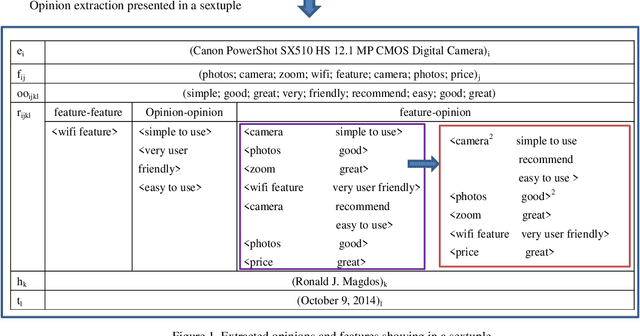
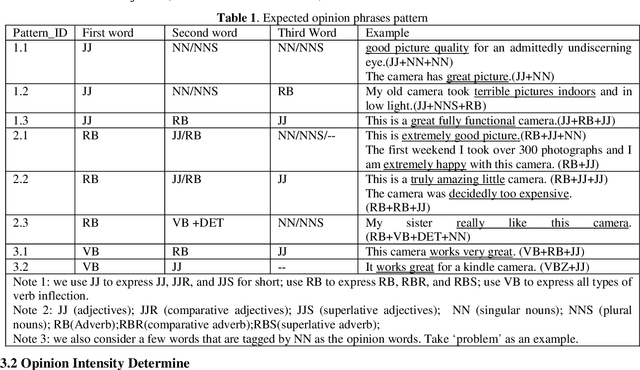
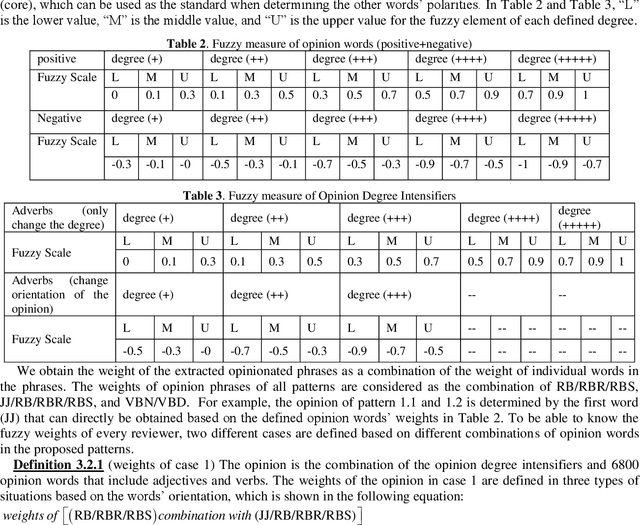
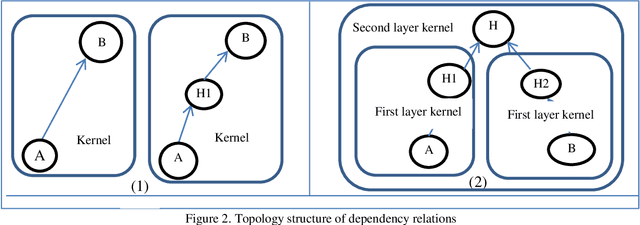
Abstract:Opinion mining mainly involves three elements: feature and feature-of relations, opinion expressions and the related opinion attributes (e.g. Polarity), and feature-opinion relations. Although many works have emerged to achieve its aim of gaining information, the previous researches typically handled each of the three elements in isolation, which cannot give sufficient information extraction results; hence, the complexity and the running time of information extraction is increased. In this paper, we propose an opinion mining extraction algorithm to jointly discover the main opinion mining elements. Specifically, the algorithm automatically builds kernels to combine closely related words into new terms from word level to phrase level based on dependency relations; and we ensure the accuracy of opinion expressions and polarity based on: fuzzy measurements, opinion degree intensifiers, and opinion patterns. The 3458 analyzed reviews show that the proposed algorithm can effectively identify the main elements simultaneously and outperform the baseline methods. The proposed algorithm is used to analyze the features among heterogeneous products in the same category. The feature-by-feature comparison can help to select the weaker features and recommend the correct specifications from the beginning life of a product. From this comparison, some interesting observations are revealed. For example, the negative polarity of video dimension is higher than the product usability dimension for a product. Yet, enhancing the dimension of product usability can more effectively improve the product (C) 2015 Elsevier Ltd. All rights reserved.
Optimized Hidden Markov Model based on Constrained Particle Swarm Optimization
Nov 07, 2018Abstract:As one of Bayesian analysis tools, Hidden Markov Model (HMM) has been used to in extensive applications. Most HMMs are solved by Baum-Welch algorithm (BWHMM) to predict the model parameters, which is difficult to find global optimal solutions. This paper proposes an optimized Hidden Markov Model with Particle Swarm Optimization (PSO) algorithm and so is called PSOHMM. In order to overcome the statistical constraints in HMM, the paper develops re-normalization and re-mapping mechanisms to ensure the constraints in HMM. The experiments have shown that PSOHMM can search better solution than BWHMM, and has faster convergence speed.
Infrastructure for the representation and electronic exchange of design knowledge
Oct 31, 2018



Abstract:This paper develops the concept of knowledge and its exchange using Semantic Web technologies. It points out that knowledge is more than information because it embodies the meaning, that is to say semantic and context. These characteristics will influence our approach to represent and to treat the knowledge. In order to be adopted, the developed system needs to be simple and to use standards. The goal of the paper is to find standards to model knowledge and exchange it with an other person. Therefore, we propose to model knowledge using UML models to show a graphical representation and to exchange it with XML to ensure the portability at low cost. We introduce the concept of ontology for organizing knowledge and for facilitating the knowledge exchange. Proposals have been tested by implementing an application on the design knowledge of a pen.
Ontology based system to guide internship assignment process
Jan 18, 2017

Abstract:Internship assignment is a complicated process for universities since it is necessary to take into account a multiplicity of variables to establish a compromise between companies' requirements and student competencies acquired during the university training. These variables build up a complex relations map that requires the formulation of an exhaustive and rigorous conceptual scheme. In this research a domain ontological model is presented as support to the student's decision making for opportunities of University studies level of the University Lumiere Lyon 2 (ULL) education system. The ontology is designed and created using methodological approach offering the possibility of improving the progressive creation, capture and knowledge articulation. In this paper, we draw a balance taking the demands of the companies across the capabilities of the students. This will be done through the establishment of an ontological model of an educational learners' profile and the internship postings which are written in a free text and using uncontrolled vocabulary. Furthermore, we outline the process of semantic matching which improves the quality of query results.
An Ontology-based Knowledge Management System for Industry Clusters
Jun 03, 2008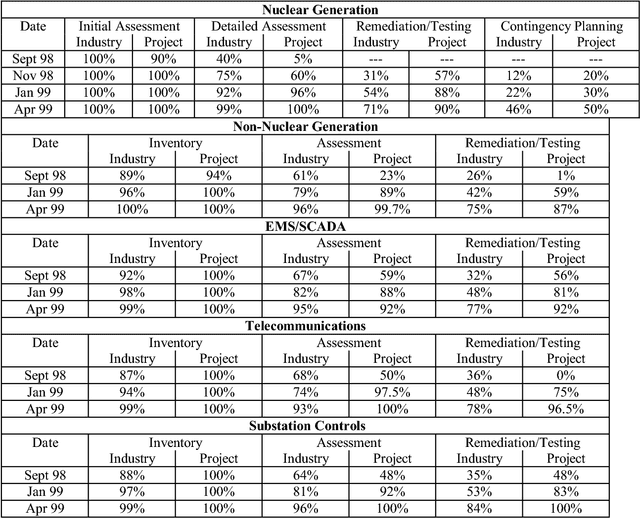
Abstract:Knowledge-based economy forces companies in the nation to group together as a cluster in order to maintain their competitiveness in the world market. The cluster development relies on two key success factors which are knowledge sharing and collaboration between the actors in the cluster. Thus, our study tries to propose knowledge management system to support knowledge management activities within the cluster. To achieve the objectives of this study, ontology takes a very important role in knowledge management process in various ways; such as building reusable and faster knowledge-bases, better way for representing the knowledge explicitly. However, creating and representing ontology create difficulties to organization due to the ambiguity and unstructured of source of knowledge. Therefore, the objectives of this paper are to propose the methodology to create and represent ontology for the organization development by using knowledge engineering approach. The handicraft cluster in Thailand is used as a case study to illustrate our proposed methodology.
 Add to Chrome
Add to Chrome Add to Firefox
Add to Firefox Add to Edge
Add to Edge